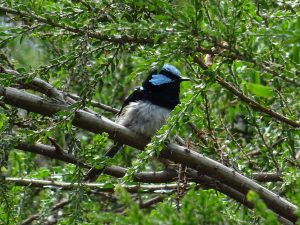Western Australia is one of the world’s largest states and bounds of outstretched landscapes are navigated by travellers who discover incredible wildlife experiences along the way. From the depths of the Southern Ocean off the coast of Albany to the captivating coral colonies of Ningaloo Reef, there is breathtaking and oftentimes unique wildlife to encounter. Western Australia also just happened to be my home for most of my childhood. This meant I was able to experience some of these incredible wildlife experiences while I was there. Hopefully, these experiences will coax you in mapping out your own Western Australian wildlife journey!

Bike ride around Rottnest Island to spot quokkas
Rottnest Island, only 19 kilometres off the coast of Perth, was once stumbled upon by Dutch captain Willem de Vlamingh in 1696. He spent a few days on the island and decided to name it ‘Rotte Nest’. The reason? He mistook the local wallaby-like marsupials, quokkas, as rats (‘Rotte Nest’ translated to “rat’s nest”). The traditional owners of Rottnest, the Noongar people, were more established and connected to Rottnest having inhabited the area while it was still attached to the Western Australian mainland 7000 years ago. They eventually named the island ‘Wadjemup’, or ‘place across the water’ when the island was separated from Western Australia after rising sea levels. Rottnest’s curious marsupials were eventually given their namesake by those indigenous to the area, and it’s what we know them as today.
Many now make the journey to Rottnest Island, or ‘Rotto’, by ferry to frolic in aquamarine waters edging the fine sands. There are next to no cars here, so the best way to explore Rottnest Island is by hiring a pushbike. Take your time to circumnavigate the island when you can witness its famous native resident; one of the only places to experience them. Quokkas are generally nocturnal so you’ll spot these gorgeous mammals in their element resting and dozing in the shade under native bushes and tea trees roadside. Though, keep your eyes peeled for an occasional spotting of an active quokka with a baby in her pouch. A bike ride will also bring you face-to-face with Rottnest Island’s intriguing salt lakes.
Snorkel alongside whale sharks at Ningaloo Reef
The northern west coast of Western Australia is where one of the world’s biggest fringing reefs lie – Ningaloo Reef. Stunning marine wildlife awaits snorkelers at this unmissable World Heritage-listed marine park. Rare turtle species and manta ray swim through schools of over 500 species of native fish and a rainbow of coral bridges. Ningaloo Reef is also one of the world’s most accessible reefs for snorkelers who effortlessly swim out to it from the beach. What really draws in the travellers is Ningaloo Reef’s ultimate marine experience – swimming with incredible whale sharks. Between April to July annually, those visiting the area can swim alongside this gathering of the world’s largest fish that grow up to 16 metres long!
Western Australia’s “gentle giants” swim throughout one of Australia’s pristine ecosystems, making a journey to Ningaloo Reef an extraordinary and unique travel experience. You can partake in this exhilarating adventure by booking a tour with an operator from Exmouth or Coral Bay. Ningaloo Reef is also popular for its yearly visit of humpback whale pods migrating to the area between June and November. You can also cap off your Ningaloo experience by taking a kayak to a remote area and spot peaceful dugongs.
Join a whale-watching trip in Albany
Starting in Western Australia’s lush south, the wildlife experiences are abundant in Albany and happen willingly seaside. This southern coastal town is Western Australia’s first European settlement and home to some of Australia’s impressive oceanic creatures. What is ironic about Albany, is that the town was once a flourishing whaling town. Nestled by the Stirling Ranges and cradled by the Southern Ocean, Albany was the final destination for first settlers to arrive on the ship Amity in 1826. Over the course of 150 years, Albany whalers scoured the ocean in search of gracious southern right whales to feed its industrious ambitions. Thankfully, whaling ceased in Albany by 1978. Since then, Albany has been focused on the conservation of whale populations for visitors to enjoy.
From June to October is the best time of the year to visit Albany for whale-watching and what better way to experience these gentle, deep-sea monoliths in their natural environment than by taking a cruise from the local pier. It’s during this time of year that southern right whales are nursing their young; a beautiful opportunity to witness these whale families. If you’re visiting between August and December, discover a kaleidoscope of wildflowers carpeting the south-west region near Albany too.
Make friends with the dolphins at Shark Bay
A typical childhood memory for many West Australian residents is travelling the thousands of kilometres from Perth to Monkey Mia in Shark Bay for an encounter with the area’s adorable bottlenose dolphin population. When tourism started to spike, visitors to Monkey Mia could actually buy buckets of fish and wade out off the beach to feed these beautiful mammals. This practice started as a result of local fishermen feeding the dolphins back in the 1960s.
Common sense for conservation prevailed, and this en masse feeding was eventually phased out. Though, you can still enjoy the company that these creatures bring while in their natural habitat and partake in a controlled feeding session with a ranger daily. Dolphins play in their pristine, water wilderness and have been doing so here for about 40 years. Shark Bay itself is a World Heritage-listed area and spans over 2 million hectares across two peninsulas. The local Malgana people named this area Gathaagudu, or ‘two waters’. No wonder the dolphins have been coming to this area for so long! Some of Monkey Mia’s quieter attractions can be experienced as well – dugongs, manta rays and turtles that inhabit Shark Bay.
For an all-encompassing experience, head to the ancient stromatolites located at Hamelin Pool where you’ll witness some of the largest and oldest living fossils on the planet. And for a novelty, bury yourself in miniscule shells at Shell Beach. It’s a beach formed from an uncountable amount of shells; one of the only places on the planet where shells replace beach sand.
Have you ever visited Western Australia and experienced one of these incredible wildlife experiences? Or, do you have plans to visit in the near future? Feel free to share your plans in the comments below. I’d love to hear your Western Australian travel stories!




